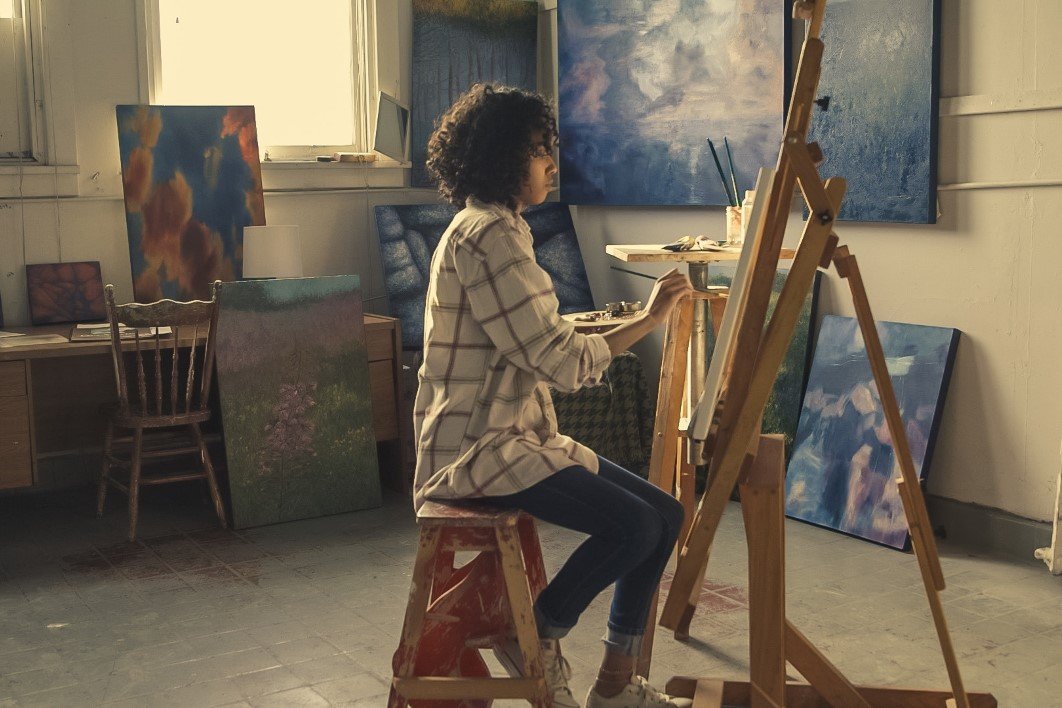The Importance of Creating Art Studio Space
To have a sacred place is an absolute necessity for anybody today. You must have a room or a certain hour of the day or so, where you do not know who your friends are, you don’t know what you owe anybody or what they owe you. This is a place where you can simply experience and bring forth what you are and what you might be. —Joseph Campbell
I remember the late nights in my bedroom at the age of 20; the smell of oil paint and turpentine filled the air, and I would paint until the wee hours until I was too tired to continue. I fell in love with painting after just one art class in college, and since then I have always managed to carve space out for myself to make art. It can be challenging to maintain a consistent art practice without dedicated space, yet having a studio space is not feasible for many people. So how can we be creative about developing space for our art practice? And why is this space so important?
First, we need to feel that we DESERVE the space to make art In addition, we need to feel worthy of taking up space on living room, gallery and museum walls, and worthy of taking up space in the world. So this idea of needing space is not just about the space in which art is made; it’s the space we allow ourselves to exist as people and artists. Giving ourselves space to make art is a gift, and one that I think is well worth giving.
Why Dedicated Art-Making Space is Important
The only thing I know is that if I get to my studio, that means I’m alive today.—Robert Farber
We have to decide that we are worth having studio space: that what we want to make is worth the effort, time, investment and physical space it takes to make it happen. In my 20 years working with students of all ages, and my 28 years of being an artist, I know that people are subject to feeling vulnerable, ashamed, fearful and hesitant when making art, let alone showing it to the world.
The solace I can offer here is that almost all artists have experienced these feelings too; they are part of the process. It takes courage to create and show art, but I believe the benefits of understanding ourselves more through making art far outweigh temporary feelings of fear.
Also, making art puts us in right-brain mode, relaxes us and helps us feel connected. We get in touch with ourselves, and sometimes bring out things we didn’t know were lingering. Therefore, the most important thing is to MAKE the art, regardless of where it is. Setting up a place that you can continually return to, however, will facilitate your willingness and ability to work.
If you are serious about art-making, then figure out a space for yourself. Regardless of the size of the space, I can’t stress how important it is to have a creative sanctuary all to yourself. The ability to have a table where your art supplies are strewn about or organized neatly in a small cart next to the table will make it so much easier to sit down and work. And the easier we make it for ourselves, the more art we will create.
How to Create an Affordable Art Studio Space in Your Home
All an artist needs is enough space to create real art. I hardly left my 3×3 meter room for more than a year. I created a new “city,” a refuge I sought when I felt alienated in my own city.—Nidaa Badwan, a young artist in Gaza City
-
Set Up A Table in the Living or Dining Room
Perhaps the easiest way to carve out some space is to use or set up a table in your living or dining room. If you don’t want to take over the kitchen table, then you can purchase a foldable four or or six-foot plastic table for an affordable price, and it tucks away easily.
If you aren’t able to leave your supplies out on the table, then I would purchase a 3-drawer storage bin or one huge plastic storage box and keep all your supplies inside. You could even drape a nice table cloth over the bin if you don’t want it to look unsightly in the room. If you are painting, you will want to cover the table and floor with a plastic drop cloth first, and then a cloth one. This keeps any spills from ruining the table or floor.
Also, if you are using oil paints, you will need ventilation. A simple way to ventilate is to put two fans in your art-making space. One fan should be in the window and be blowing air to the outside, and the other fan should be on one side of your work area, blowing air towards the window fan. This will keep the air moving out of the room and keep you safer.
2. Your Bedroom
For a bit more privacy, set up a table or desk in your bedroom and follow the above instructions. If you live with others, your bedroom will offer you more privacy, but make sure to avoid using mineral spirits or oil paint. If you don’t share your bedroom with someone, then you can safely keep your supplies out and sit down and get to work whenever you want!
3. The Garage
If you have a garage that can spare a bit of room for you and your humble art supplies, then make it happen! Artists have been converting garages to art studios for years, but even having one small section for you creative pursuits is helpful. How terrible would it be to park your car out front instead of in the garage? Is your creative freedom worth it? This is for you to decide, but my vote is to take the garage over if you are able. There are a lot of informative blogs about converting your garage to an art studio, so get researching and make it happen!
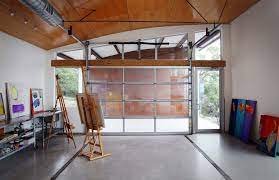
You wouldn’t have to twist my art to paint in this converted garage studio.
4. Your Backyard or Patio
Have a covered yard or patio? Willing to set up a plastic table and have a big drop cloth on hand to cover it to protect it from the elements? Well this might be the most pleasant of all the solutions. Working outside allows us to get some fresh air and perhaps find new inspiration in our environment. A big plastic bin that closes well should protect your supplies from rain, but you may want to bring any papers inside just to be safe. If you need shade, consider purchasing an outdoor umbrella.
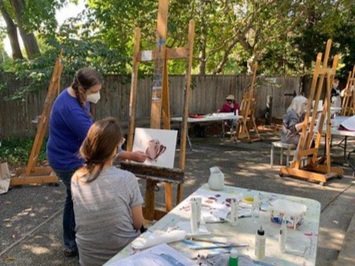
What a lovely place to work! The outdoor studios at the Palo Alto Art Center in California.
5. The Basement
This one highly depends on where you live. In New Mexico, it’s rare for houses to have a basement. In wetter environments, basements can be funky places. But if you have a decent basement, go ahead and take over a part of it for your art pursuits. Painting the walls white in that area would go a long way to give you more light. And you can add inexpensive shop lights in your space for quick and easy studio light.
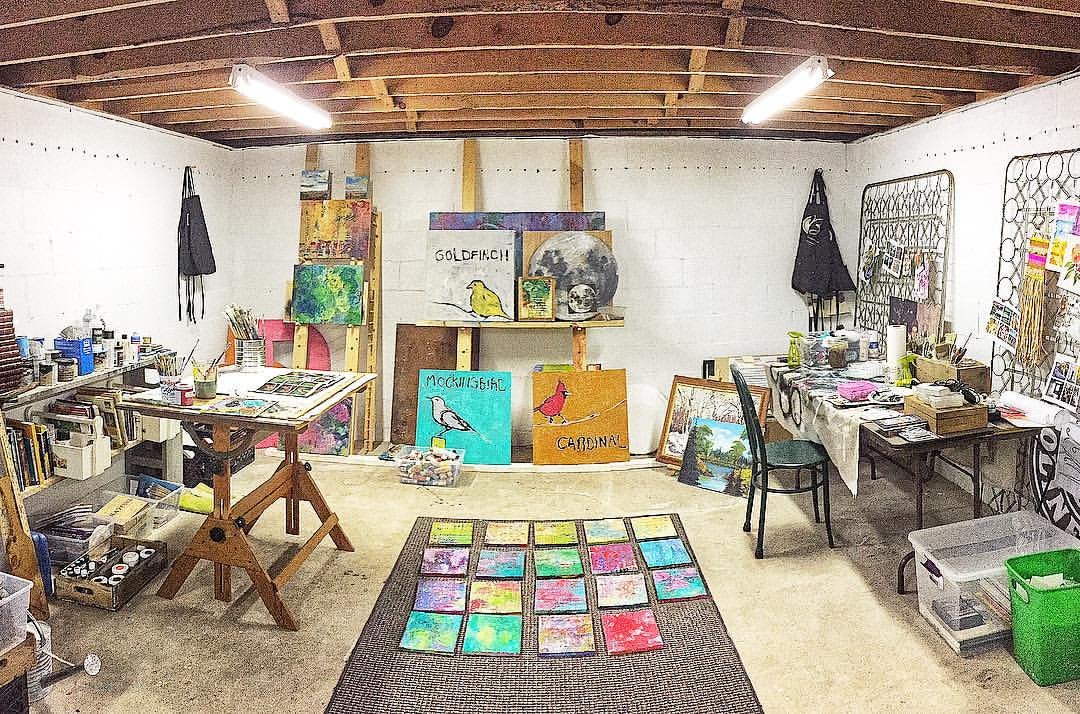
Check out Ashley Hackshaw’s converted basement art studio. She takes you through the whole process on her blog post entitled Creating An Art Studio-My Basement Art Studio Transformation.
Never apologize for your studio.—Denise Bezanson
6. A Shed
There’s a whole gaggle of people who have turned Tuff Sheds into amazing art studios. This is going to be the most expensive option of all the suggestions listed here, but certainly much cheaper than renting a studio or adding onto your home. I love how customizable studio sheds can be. You can choose the size, height, and color of the shed, and decide where to put windows and skylights. A quick google image search will flood your mind with ideas.
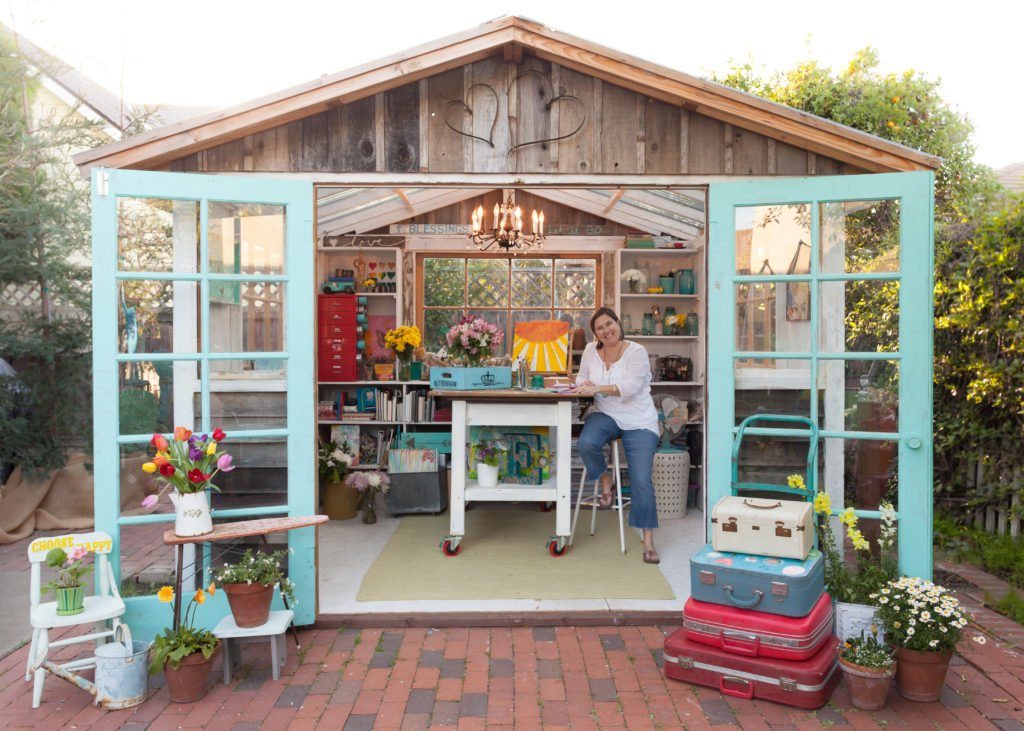
Jenny Karp in her she-shed art studio.
Taking Space: An Art Exhibition at PAFA
Beyond the need for physical space to make art, let’s consider the role of space in our lives in other ways. The Pennsylvania Academy of Fine Arts, located in Philadelphia, had an exhibition in early 2021 entitled Taking Space: Contemporary Women Artists and the Politics of Scale.
The show examined how various women artists addressed space in their artworks, “whether they take the space on a wall, the real estate of a room through sculpture and installation, engage seriality as a spatial visual practice, cast a wide legacy in art history or claim the space of their body.” – (https://www.pafa.org/museum/exhibitions/taking-space)
When I view the works from the exhibition online, I feel a deeper sense of resolve and gratitude that I have gifted myself the space to make art, the space to show art, and the space to be myself. You might have a different perspective on the importance of space in your life, as the over 50 women who were part of the show, including some heavy-hitters such as Faith Ringgold, Barbara Krueger, Betye Saar, Alice Neel, Wangechi Mutu, the Guerilla Girls, and Miriam Schapiro.
Can you put that perspective on paper, in your very own personal art space? Why is space important to you? Why is art-making important to you? How can you make art more often? These are good questions to ask as you delve into your own carving out of space for art in your life.
Conclusion
Let’s review the reasons why you might consider “taking space” for your art-making:
1-You are Worth it & Deserve It
2-You Will Make Art More Often
3-Making Art is Relaxing, Inspiring & Self-Revelatory
And here’s a quick re-cap on different ways you can create an affordable art studio space:
1—Set up an art table w/a storage cart or bin in your bedroom, living room, or dining room.
2—Convert a section of your garage or basement into an art studio.
3—Purchase or convert your shed to an art studio.
I would love to see pictures of your art studio and hear your story. Reach out or comment below!
ABOUT ANDREA CERMANSKI
I am an artist out of Santa Fe, New Mexico who has been painting for almost 30 years. I love to teach first-timers as well as experienced painters who need a creative reboot. My work has been displayed in several galleries around the country, and I have a Bachelor’s in Art History, a Master’s in Art Education, and had my work in a show juried by Judy Chicago. The idea of getting more people painting makes me light up as I want to inspire more people to express their creative selves and tap into a place of joy and calm.
WANT TO LEARN MORE?
- Subscribe and get a FREE PDF explaining How to Use My 5 Favorite Mediums
- Check out My Online Painting Course & Group Coaching Programs
- Read More Painting Tips Blog Posts
- Learn About 3-Day Painting Retreats in Santa Fe
- Check out My Paintings & Art Prints for Sale
- Follow me on Youtube, Instagram, or Pinterest
